| Image search results - "AE1" |

JULIAN II - AE1 - 361-363 - Mint of Antioch
Obv.: D N FL CL IVLIANVS P F AVG
Pearl-diademed, draped and cuirassed bust right
Rev.: SECVRITAS REIPVB
Bull standing right, two stars above; (palm) ANTB (palm).
Maxentius
|
|

Syria Seleucia Pieria AE14
Apollo & tripod. Cop. 399, S 2184 Date: 100BC
Obverse: Head of Apollo right Reverse: Tripod
Size: 14.43 mm Weight: 2.3 grams Coin #621cars100
|
|

Antiochos VIII AE19. Diademed & radiate head right
/ BASILEWS ANTIOCOU EPIFANOUS, eagle
standing left on thunderbolt, scepter behind shoulder.
SNGIs 2501. Coin #620
cars100
|
|
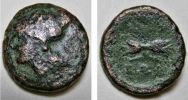
Bruttium, Lokroi Epizephyrioi
300-268 BC 5.27 g (1942) SNG Danish National Museum
1874 4.92 g (1975) SNG ANS 3 543
AE18 of Locri (Locroi Epizephyrii), 290-270 BC or later
Obv. hd Athena, wearing Corinthian helmet
Rev.winged thunderbolt, LOKRWNCoin #616
cars100
|
|
|

16mm, 2.14g
obv: ZEYC; diademed bust right
rev: ΤΡΑΛΛΙΑΝΩΝ; zebu bull right, star below
BMC 22, p. 342, #101-2areich
|
|
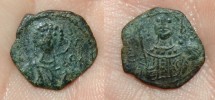
Manuel I, Comnenus. 1143-1180 AD. AE 1/2 Tetarteron, Greek Mint, 1.2 grams. AE14. (As SB1975 but much smaller). P-over-w GIOC to left of bust facing of St. George, unbearded, nimbate, wearing tunic, cuirass and cloak, holding spear and shield / MANVHL DECPOTH (or MANOVHL DEC), crowned, unbearded bust facing of Manuel, wearing loros, holding labarum and cross on globe. SB 1980, BMC 78.
1.0 gr. 11mm.Antonivs Protti
|
|
|
|
|
|
|

Klein 337 Larissa Phrikonis, Aeolis. (AE14, 1.59 grams) 10.76mm, .89g, 4th century BC. head of Apollo right / LARISA, bull standing right. Klein 337; Sear -; Mionnet -; BMC-.Castvlo
|
|
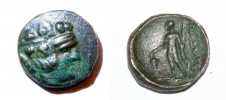
Maroneia, Thrace. 146-100BC, AE18mm.
Obv. Wreathed head of young Dionysos right. Rev. Dionysos left holding grapes, NARTHEX in right field, monogram in near left field.Lee S
|
|

Apameia in Phrygia, 133-48 B.C, AE17mm, Obv. Turreted bust of Artemis right, bow and quiver at shoulder. Rev. Naked Marsyas advancing right, playing double flute, to right, KHΦIΣO - ΣKAY
Sear 5122; BMC 25.85,91-3Lee S
|
|
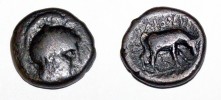
Macedonia under Roman rule. Gaius Publius Quaestor. 148-146BC. AE19mm. Obv. Athena in crested helmet. Rev. Grazing cow right. GAIOY TAMIOU. SNG ´Cop. 1323Lee S
|
|
|
|

Aeolidis, Aegaea. AE18. Circa 43-48, 3.28 gm.
Obv BPITANNIKOC KAICAP Bare head of Britannicus r.
Rev : AIGAEWN EPI CALE / OU Zeus standing l., holding eagle and sceptre.
Ref : RPC 2431 (5 ex known)R. Smits
|
|

GAUL: Anonymous, circa 80-52 BC, AE15, cf. D&T 2638 (for style), stylized Alexandrian head right // YLLYCCV (?) around sylized eagle standing left; pentagram and pellets-in-annulets to rightQuant.Geek
|
|
|
|

Roman Republic - P. Satrienus. Silver denarius (3,82 g., 18 mm.) Minted in Rome in 77 B.C.
Helmeted head right of young Mars, numeral behind (XXXII). /
ROMA She-wolf walking left. P•SATRIE/NVS in exergue.
Sear 319; Satriena 1; Cr. 388/1b.paul1888
|
|
|

Roman provincial Gordian III AE24 Asklepius
Gordian III AE19 of Deultum, Thrace.,
Obv: Gordian III right, rev: Asklepios standing front, looking left, leaning on serpent-entwined staff.
23.5mm.,7.98g. paul1888
|
|

Constantius Gallus, Cyzicus. AE18. DN CONSTAN-TIVS NOB CS, bare-headed, draped, cuirassed bust right / FEL TEMP-REPARATIO, soldier standing left, spearing fallen horseman who has no beard, wears Phrygian helmet, reaching backwards. Mintmark SMK epsilon. RIC VIII Cyzicus 107.Antonivs Protti
|
|

Amyntas III, 393 - 370/369 BC. AE17 Dichalkon. Struck at an uncertain mint in MacedoniaObverse: No legend. Head of Herakles, wearing lion's skin, facing right.
Reverse: AMYNTA above Eagle standing facing right, grasping snake in it's talons and attacking it with it's beak.
Diameter: 16.92mm | Weight: 3.17gms | Die Axis: 6
SNG ANS 100 - 109 | SNG Munchen 49-52 | AMNG 160, 7
Amyntas III was king of Macedonia from about 393 to 370/369 BC, he was the father of Philip II and the grandfather of Alexander the Great. His skillful diplomacy in Greek affairs prepared the way for Macedonia's emergence as a great power under his son Philip II.
Amyntas came to the throne during a period of some confusion after the sudden death of king Archelaus who was killed while out hunting in 399 BC. Archelaus was succeeded by his young son Orestes, who ruled with his guardian Aeropus for four years until his death, possibly at the hands of Aeropus. Aeropus then ruled alone as Aeropus II, until he died of an illness two years later and was succeeded by his son Pausanius.
Diodorus gives two versions of the start of Amyntas' reign but both versions agree that Amyntas came to the throne after assassinating Pausanias but was then driven out by the Illyrians. Amyntas recovered his kingdom in the following year however, with the aid of the Spartans and the Thessalians. He continued to maintain his position by the expedient of siding with the powers ascendant in Greece, securing his alliance with Athens by supporting their claim to Amphipolis, and by adopting the Athenian general Iphicrates as his son. Iphicrates later helped Amyntas' son, Perdikkas III, to secure his claim to the throne.
Several significant figures worked in Macedonia during Amyntas' reign, including Nicomachus, the father of Aristotle, who served as court physician to Amyntas, and Aristotle himself who served as the tutor to Amyntas' grandson, Alexander the Great.
Amyntas died at an advanced age in 370-369 BC, leaving his throne to the eldest of his three sons, Alexander II, who ruled from 369 to 366 BC. Amyntas' other two sons also ended up ruling Macedon, Perdikkas III from 365 to 359 BC and Philip II, the father of Alexander the Great, from 359 to 336 BC.*Alex
|
|

Philip II, 359 - 336 BC. AE18. Struck after 356 BC at an uncertain mint in MacedoniaObverse: No legend. Young male head, usually identified as Apollo, with hair bound in a taenia, facing left.
Reverse: ΦIΛIΠΠOY, Naked rider on horse prancing left, uncertain control mark, often described as the head of a lion, beneath the horse. The control mark looks a bit like the ram on the prow of a galley to me, but that is just my personal opinion.
Diameter: 17.4mm | Weight: 6.9gms | Die Axis: 12
SNG ANS 872 - 874
The bronze series of this type is extensive and differentiated principally by the different control marks. These control marks are symbols and letters which generally appear on the reverse, very occasionally the obverse, of the coin, and they were used to identify the officials responsible for a particular issue of coinage.
Philip II won the horseback race at the 106th Olympics in 356 BC, and it is thought that the horseman on the reverse of this coin commemorates that event.
Philip II of Macedon was King of Macedon from 359 until his death in 336 BC. He was the father of Alexander the Great and Philip III Arrhidaeus. In 357 BC, Philip married Olympias, who was the daughter of the king of the Molossians. Alexander was born in 356 BC, the same year as Philip's horse won at the Olympic Games.
Only Greeks were allowed to participate in the Olympic Games, and Philip was determined to convince his Athenian opposition that he was indeed worthy to be considered Greek. And, after successfully uniting Macedonia and Thessaly, Philip could legitimately participate in the Olympics. In 365 BC Philip entered his horse into the keles, a horseback race in the 106th Olympics, and won. He proceeded to win two more times, winning the four horse chariot race in the 352 BC 107th Olympics and the two horse chariot race in the 348 BC 108th Olympics. These were great victories for Philip because not only had he been admitted officially into the Olympic Games but he had also won, solidifying his standing as a true Greek.
The conquest and political consolidation of most of Greece during Philip's reign was achieved in part by the creation of the Macedonian phalanx which gave him an enormous advantage on the battlefield. After defeating Athens and Thebes at the Battle of Chaeronea in 338 BC Philip II established the League of Corinth, a federation of Greek states, with him at it's head, with the intention of invading the Persian empire. In 336 BC he sent an army of 10,000 men into Asia Minor to make preparations for the invasion by freeing the Greeks living on the western coast and islands from Persian rule. All went well until the news arrived that Philip had been assassinated. The Macedonians were demoralized by Philip's death and were subsequently defeated by Persian forces near Magnesia.
Philip II was murdered in October 336 BC, at Aegae, the ancient capital of the Macedonian kingdom, while he was entering into the town's theatre. He was assassinated by Pausanius, one of his own bodyguards, who was himself slain by three of Philip's other bodyguards. The reasons for Philip's assassination are not now fully known, with many modern historians saying that, on the face of it, none of the ancient accounts which have come down to us appear to be credible.*Alex
|
|

Philip II, 359 - 336 BC. AE18. Struck after 356 BC at an uncertain mint in MacedoniaObverse: No legend. Young male head, usually identified as Apollo, with hair bound in a taenia, facing left.
Reverse: ΦIΛIΠΠOY, Naked rider on horse prancing right, forepart of bull butting right control mark (helmet?) beneath the horse.
Diameter: 19mm | Weight: 6.95gms | Die Axis: 9
GCV: 6699 | Forrer/Weber: 2068
The bronze series of this type is extensive and differentiated principally by the different control marks. These control marks are symbols and letters which generally appear on the reverse, very occasionally the obverse, of the coin, and they were used to identify the officials responsible for a particular issue of coinage.
Philip II won the horseback race at the 106th Olympics in 356 BC, and it is thought that the horseman on the reverse of this coin commemorates this event.
Philip II of Macedon was King of Macedon from 359 until his death in 336 BC. He was the father of Alexander the Great and Philip III Arrhidaeus. In 357 BC, Philip married Olympias, who was the daughter of the king of the Molossians. Alexander was born in 356 BC, the same year as Philip's horse won at the Olympic Games.
The conquest and political consolidation of most of Greece during Philip's reign was achieved in part by the creation of the Macedonian phalanx which gave him an enormous advantage on the battlefield. After defeating Athens and Thebes at the Battle of Chaeronea in 338 BC Philip II established the League of Corinth, a federation of Greek states, with him at it's head, with the intention of invading the Persian empire. In 336 BC, Philip II sent an army of 10,000 men into Asia Minor to make preparations for the invasion by freeing the Greeks living on the western coast and islands from Persian rule. All went well until the news arrived that Philip had been assassinated. The Macedonians were demoralized by Philip's death and were subsequently defeated by Persian forces near Magnesia.
Philip II was murdered in October 336 BC, at Aegae, the ancient capital of the Macedonian kingdom, while he was entering into the town's theatre. He was assassinated by Pausanius, one of his own bodyguards, who was himself slain by three of Philip's other bodyguards. The reasons for Philip's assassination are not now fully known, with many modern historians saying that, on the face of it, none of the ancient accounts which have come down to us appear to be credible.*Alex
|
|

Philip II, 359 - 336. AE18. Struck after 356 BC at an uncertain mint in Macedonia Obverse: No legend. Young male head, usually identified as Apollo, with hair bound in a taenia, facing right.
Reverse: ΦIΛIΠΠOY, Naked rider on horse prancing right, retrograde E control mark beneath the horse.
Diameter: 17.16mm | Weight: 6.09gms | Die Axis: 12
SNG ANS 919 - 920
The bronze series of this type is extensive and differentiated principally by the different control marks. These control marks are symbols and letters which generally appear on the reverse, very occasionally the obverse, of the coin, and they were used to identify the officials responsible for a particular issue of coinage.
Philip II won the horseback race at the 106th Olympics in 356 BC, and it is thought that the horseman on the reverse of this coin commemorates this event.
Philip II of Macedon was King of Macedon from 359 until his death in 336 BC. He was the father of Alexander the Great and Philip III Arrhidaeus. In 357 BC, Philip married Olympias, who was the daughter of the king of the Molossians. Alexander was born in 356 BC, the same year as Philip's horse won at the Olympic Games.
The conquest and political consolidation of most of Greece during Philip's reign was achieved in part by the creation of the Macedonian phalanx which gave him an enormous advantage on the battlefield. After defeating Athens and Thebes at the Battle of Chaeronea in 338 BC Philip II established the League of Corinth, a federation of Greek states, with him at it's head, with the intention of invading the Persian empire. In 336 BC, Philip II sent an army of 10,000 men into Asia Minor to make preparations for the invasion by freeing the Greeks living on the western coast and islands from Persian rule. All went well until the news arrived that Philip had been assassinated. The Macedonians were demoralized by Philip's death and were subsequently defeated by Persian forces near Magnesia.
Philip II was murdered in October 336 BC, at Aegae, the ancient capital of the Macedonian kingdom, while he was entering into the town's theatre. He was assassinated by Pausanius, one of his own bodyguards, who was himself slain by three of Philip's other bodyguards. The reasons for Philip's assassination are not now fully known, with many modern historians saying that, on the face of it, none of the ancient accounts which have come down to us appear to be credible.*Alex
|
|

Philip II, 359 - 336. AE18. Struck after 356 BC at an uncertain mint in MacedoniaObverse: No legend. Young male head, usually identified as Apollo, with hair bound in a taenia, facing right.
Reverse: ΦIΛIΠΠOY, Naked rider on horse prancing left, spearhead control mark beneath the horse.
Diameter: 18.00mm | Weight: 6.00gms | Die Axis: 12
SNG ANS 850 | Mionnet I: 750
The bronze series of this type is extensive and differentiated principally by the different control marks. These control marks are symbols and letters which generally appear on the reverse, very occasionally the obverse, of the coin, and they were used to identify the officials responsible for a particular issue of coinage.
Philip II won the horseback race at the 106th Olympics in 356 BC, and it is thought that the horseman on the reverse of this coin commemorates this event.
Philip II of Macedon was King of Macedon from 359 until his death in 336 BC. He was the father of Alexander the Great and Philip III Arrhidaeus. In 357 BC, Philip married Olympias, who was the daughter of the king of the Molossians. Alexander was born in 356 BC, the same year as Philip's horse won at the Olympic Games.
The conquest and political consolidation of most of Greece during Philip's reign was achieved in part by the creation of the Macedonian phalanx which gave him an enormous advantage on the battlefield. After defeating Athens and Thebes at the Battle of Chaeronea in 338 BC Philip II established the League of Corinth, a federation of Greek states, with him at it's head, with the intention of invading the Persian empire. In 336 BC, Philip II sent an army of 10,000 men into Asia Minor to make preparations for the invasion by freeing the Greeks living on the western coast and islands from Persian rule. All went well until the news arrived that Philip had been assassinated. The Macedonians were demoralized by Philip's death and were subsequently defeated by Persian forces near Magnesia.
Philip II was murdered in October 336 BC, at Aegae, the ancient capital of the Macedonian kingdom, while he was entering into the town's theatre. He was assassinated by Pausanius, one of his own bodyguards, who was himself slain by three of Philip's other bodyguards. The reasons for Philip's assassination are not now fully known, with many modern historians saying that, on the face of it, none of the ancient accounts which have come down to us appear to be credible.*Alex
|
|

4 Caligula AE16 of CassandreaCassandrea, Macedonia
AE16, Time of Caligula
Standard/Vexilla with crescents above // CAS/SAN/DR within wreath
Thanks to FORVM member Quisquam for helping me attribute this little coin.
RI0017Sosius
|
|
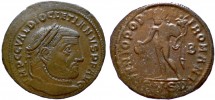
1 DiocletianDIOCLETIAN
AE1 Follis (9.63g), Serdica Mint, Struck 303-305 AD
R: GENIO POPVLIA ROMANI, Genius standing l. pouring liquid from patera and holding cornucopia, .SM.SD. in ex., B in r. field
RIC 3a, Officina B-2
Ex Harlan J. BerkSosius
|
|

1 DiocletianDiocletian
AE1 Follis.
IMP C DIOCLETIANVS P F AVG, laureate head right / GENIO POPV-LI ROMANI, Genius standing left, modius on head, naked but for chlamys over left shoulder, with patera & cornucopiae, mintmark PT in ex.
Ticinum RIC 29a Sosius
|
|

1 DiocletianDiocletian
AE1. 294 AD
IMP CC VAL DIOCLETIANVS P F AVG, laureate head right / GENIO POPVLI ROMANI, Genius standing left, holding patera & cornucopiae, H and officina letter in ex.
Heraclea, RIC VI 12a Sosius
|
|

12 Domitian and DomitiaDomitian & Domitia
AE19mm of the Thessalian Confederacy, probably minted at Larissa.
ΔΟΜΙΤΙΑΝΟΝ ΚΑΙΣΑΡΑ ΘΕΣΣΑΛΟΙ, laureate head of Domitian right / ΔΟΜΙΤΙΑΝ ΣΕΒΑΣΣΣΤΗΝ, diademed bust of Domitia right.
RPC 277; Rogers 88.
RI0031Sosius
|
|

14 Trajan AE18 of Mysia, AttaeaTRAJAN,
Mysia, Attaea, AE18
AV TRAIANOC KAI, laureate bust right / ATTAIATWN, draped bust of Senate right.
BMC 5; SNG Copenhagen 32; Von Fritze 373.
RI0127Sosius
|
|
|
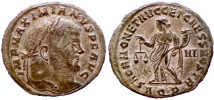
2 MaximianMAXIMIANUS
AE1 Follis. 300 AD
IMP MAXIMIANVS P F AVG, laureate head right / SACRA MONET AVGG ET CAESS NOSTR, Moneta standing left, holding scales & cornucopia, AQP in ex.
RIC Aquileia 29b
Sosius
|
|

25 CaracallaCaracalla
AE17 of Nikopolis ad Istrum.
Laureate head right / Bull grazing right, inscription begins below bull in exergue
Not in references VFSosius
|
|

25 Caracalla AE 18 of NicopolisCaracalla
AE 18, Nicopolis
Bust right / Tripod with snake
HrHJ (2012) 8.18.47.15
Thanks to FORVM member Jochen for his help identifying this coin.
Sosius
|
|
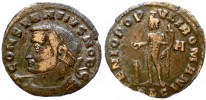
3 Constantius ICONSTANTIUS I
AE1 Folles, Lyons, Struck 301-301 AD
CONSTANTIVS NOB C, Laureate cuirassed bust l.., scepter over r. shoulder / GENIO POP-VLI ROMANI, Genuis standing left by altarholding patera and cornucopiae, A in l. field, PLG in ex.\\\\\\\\
RIC VI Lyons 167aSosius
|
|

30 Severus AlexanderSEVERUS ALEXANDER
AE19. Bithynia, Nicaea.
M AVP CEVH ALEXANDROC AV, laureate, draped and cuirassed bust right / N-IK-AI-E - WN between and beneath three standards.
BMC 103 Sosius
|
|

73 Constantius II, Arles RIC VII 342v (added to wildwinds)Constantius II
AE18, 2.2g, Arles. 330-348 AD.
FL IVL CONSTANTIVS NOB C, laureate, draped, cuirassed bust right / GLOR-IA EXERC-ITVS, two soldiers holding spears and shields, standing left and right of two standards with thin poles and small badges. Star between standards. Mintmark SCONST.
RIC VII Arles 347v. Sear (2014) 17676 EF, irregular flan
Note: Coin unique due to star placement. Added to Wildwinds in May 2011Sosius
|
|

Antiochus III AE10SNGIs 615v
Seleucid Kingdom,
Antiochus III AE10.
Diademed head right /
BASILEWS ANTIOXOY, elephant standing left. xokleng
|
|

AURELIAN & VABALATHUS. ANTONINIANUS, 270-275 AD. AE19-20mm. AURELIAN & VABALATHUS. ANTONINIANUS, 270-275 AD.
Obv. IMP C AVRELIANVS AVG, radiate, cuirassed bust of Aurelian
REV. VABALATHVS VCR IM DR, laureate bust of Vabalathus.
Ref. RIC Vi 381; Cohen 1; Sear5 11718.Lee S
|
|

Claudius II Gothicus. 268-270 AD. AE18mm Claudius II Gothicus. 268-270 AD.
Obv. IMP CLAVDIVS P F AVG, radiate, draped, and cuirassed bust right.
Rev. PA-X A-VG, Pax advancing left, holding transverse scepter in left hand and olive branch in right hand;
T in ex. Mediolanum (Milan) mint.
Ref. RIC 157
Ex Forvms Never-Ending Cleaning Competition.Lee S
|
|

Constantine II, RIC 381 var. TrierConstantine II, AE19, Trier. 322-323 CE
Obverse: CONSTANTINVS IVN NOB C, laureate and cuirassed bust right, holding spear over shoulder and horse by the bridle before.
Reverse: BEATA TRAN-QVILLITAS, large globe on an altar inscribed V dot O - TIS - XX in three lines, three stars above.
Mintmark: PTR dot., RIC VII Trier 381 var (mintmark) 18.9 mm, 2.7 g.
NORMAN K
|
|
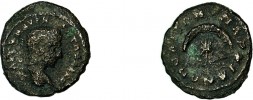
Elagabalus, Varbanov 1394 AE17, 218-222 CE.
056p Elagabalus, 16 May 218 - 11 March 222 A.D., Markianopolis, Moesia Inferior
Bronze AE
Varbanov 1384, VF, Markianopolis mint, 2.1g, 16.5 mm,
Obverse: AΥT K M AΥΡ ANTΩNINOC,( ΩN ligate) laureate head right; reverse Reverse:MAΡKIANOΠOΛITΩN, (AP and ΩN ligate) four stars in creasent moon.
NORMAN K
|
|

Kassander, 317 - 297 BC. AE18. Struck 319 - 305 BC at an uncertain mint in MacedoniaObverse: No legend. Head of Herakles, wearing lion's skin, facing right.
Reverse: KAΣΣAN - ΔPOY, above and below crouching lion facing right, Λ in right field, before lion.
Diameter: 17.77mm | Weight: 3.76gms | Die Axis: 6
SNG Cop 1138 | Sear GCV 6753 | Forrer/Weber 2161
This type was issued before Kassander's assumption of the royal title in 305 BC
Kassander (Cassander) was one of the Diadochoi, a group of Macedonian generals, and the self proclaimed ruler of Macedonia during the political turmoil following the death of Alexander the Great in 323 BC. He was the son of Antipater, who had been appointed as regent in Macedonia while Alexander was in the East.
In 319 BC and close to death, Antipater transferred the regency of Macedonia to Polyperchon. Kassander refused to acknowledge the new regent and, with the aid of Antigonus I Monopthalmus the ruler of Phrygia, he seized Macedonia and most of Greece, including Athens. In 317 BC, he declared himself regent and had Alexander's widow, Roxanna and son, Alexander IV confined in Amphipolis. Later, in 310 or 309 BC, he had them put to death by poisoning. But, even though he had murdered Alexander's heirs and had been the de facto ruler of Macedonia from 317 BC, Kassander did not take the royal titles and declare himself king until 305 BC.
Meanwhile, Antigonus was intent on reuniting Alexander's empire under his own sovereignty and so Kassander joined forces with Ptolemy I of Egypt, Seleucus in Babylon and Lysimachus ruler of Thrace to oppose him. The two sides fought several battles between 319 and 303 BC resulting in Kassander losing Athens in 307 BC and his possessions south of Thessaly between 303 and 302 BC. However, in 301 BC Antigonus was defeated and killed at the Battle of Ipsus in Phrygia which allowed Kassander to secure undisputed control over Macedonia.
During his rule Kassander restored peace and prosperity to the kingdom, founding or restoring numerous cities, including Thebes which had been levelled by Alexander as punishment for rebelling against him. He also founded Thessalonica, naming the city after his wife, and Cassandreia, founded upon the ruins of Potidaea, which was named after himself.
Kassander died of dropsy in 297 BC and may have been buried in a royal tomb recently discovered at Vergina, identified as Aigai, the first Macedonian capital.
*Alex
|
|

Kings of Macedon: Antigonos I struck under Demetrios I Poliorketes, AE15 Half Unit.Salamis 320-301 B.C. 3.42g - 15.5mm, Axis 12h.
Obv: Macedonian shield, boss decorated with facing gorgoneion.
Rev: Macedonian helmet, kerykeion and monogram to lower left and right.
Ref: Price 3159 (c. 323-315 BC) var. (Unit); Zapiti & Michaelidou 7-8 var. (same).
Provenance: Ex Derek Glover. Chris Scarlioli CollectionChristian Scarlioli
|
|

Thrace, Maroneia AE16mm (5.6g).Thrace, Maroneia AE16mm (5.6g).
Obverse: Head of Dionysos, wreathed in ivy
Reverse: Dionysos standing left holding bunch of grapes and thyrsos.2173
Antonivs Protti
|
|

Victorinus, Antoninianus. AE18-19mm. 269 to 271 AD.Victorinus, Silvered Antoninianus. 269 to 271 AD.
Obv. IMP C VICTORINVS P F AVG, radiate, draped & cuirassed bust right.
Rev.SALVS AVG, Salus standing right feeding serpent in arms.
Ref. RIC 67, Cohen 112, Sear 11179Lee S
|
|

#Lydia, Philadelphia. Claudius AE18Obv: T KLAYDIOS GERMANIKOS KAISAR. Laureate bust r.
Rev: P'ILADELP'EWN NEOKAISAREWN C'ONDROS. Four grain-ears bundled together.ancientone
|
|

Caracalla AE19 of Serdica, ThraceCaracalla
Thrace, Serdica
AE 19
laureate bust r.
AVT K M AV CEV ANTΩNINOC
Thanatos leaning on inverted torch
CEPΔΩN
Moushmov 4829
Ardatirion
|
|

(0306) CONSTANTINE I (THE GREAT)(0306) CONSTANTINE I (THE GREAT)
Caesar 306-307; Filius Augustorum 307-309; Augustus 309-337 AD
AE18.5 mm, 2.24 g
O: CONSTANTINVS MAX AVG Rosette-diademed, draped and cuirassed bust right.
R: GLORIA EXERCITVS Two soldiers standing with spears and shields,
two standard between them.
Constantinople mintlaney
|
|

(0351) CONSTANTIUS GALLUS351 - 354 AD
AE17 X 19 mm; 4.00 g
Obv: DN FL CL CONSTANTIVS NOB CEAS Bareheaded, draped and cuirassed bust of emperor, right.
Rev: FEL TEMP RE PARATIO Helmeted soldier to left, shield on left arm , spearing falling horseman; SMNA in exe.
Nicomedia mint
laney
|
|

(194-217) Julia Domna15mm, 2,3g
Julia Domna AE16 of Nicaea, Bithynia.
obv: IOVLIA CEBASTH, draped bust right
rev: NIKAIEWN, bull standing right.
Unlisted in Varbanov and SNG Copenhagen.B*Numis
|
|

*SOLD*Carthage, Zeugitania AE15
Attribution: SNG Cop 144 ff., Sardinia
Date: 300-264 BC
Obverse: head of Tanit l. wearing wreath of grain, earring and necklace
Reverse: horse's head r.
Size: 18.8 mm
Weight: 5.57 grams
ex-ForvmNoah
|
|

001p3. Cleopatra VII (?)Cleopatra VII (?)
AE10 (quarter obol). 13mm, 2.61 g. Paphos, Cyprus, struck circa 38-30 BC(?). Obv: Draped & diademed bust of Cleopatra VII right.
Rev: ΠTOΛEMAIOY BAΣIΛEΩΣ, double cornucopia. Svoronos 1160.
NOTE: This is a very controversial coin. Matthew Kreuzer. The Coinage System of Cleopatra VII and Augustus in Cyprus, argues that this coin was struck for Cleopatra VII. For a strong rebuttal, see Oliver D. Hoover at http://numismatics.org/magazine/cypruswinter05/. At the moment, the argument either way is unproven.
A FORUM coin.lawrence c
|
|

001w. TriumvirsSecond Triumvirate, Marc Antony, Octavian and Lepidus. AE16 of Ephesus, Ionia, 39 BC. 15.8mm, 4.54 g. Obv: Triple jugate heads right
Rev: EΦE, cult image of Artemis Ephesia facing, with supports.
RPC I 2569; BMC 191; SNG Cop 357. A FORUM coin.lawrence c
|
|

002a10. AugustusCARIA, Antioch ad Maeandrum: Augustus (27 BCE-14 CE) AE17. 2.74g, 17mm, 12h. Obv: ΣΕΒΑΣΤΟΣ ΑΝΤΙΟΧΕΩΝ; Laureate head of Augustus r. Rev: ΙΑΣΩΝΟΣ ΣΥΝΑΡΧΙΑ in laurel wreath
RPC I 2831. AMCC Auction 3, Lot 119.
lawrence c
|
|

002a13. AugustusAE17. 17mm, 6.08 g. Philippi (?), Macedonia or Parium. AVG, head right / Two colonists ploughing right with two oxen. BMC (Parium) 86-88. RPC 1656 (for Philippi).lawrence c
|
|

002a9. AugustusAE17. Kyzikos, Mysia. 16mm, 5.96 g. Obverse: Bare bust right, no legend. Reverse:ϹΕΒΑϹΤΟϹ; capricorn, left, with head turned back; monogram including ΖΚ ;.
RPC 2245lawrence c
|
|

002f1. Julia AE18 of Pergamum, Mysia. Before 2 BC. 18mm, 3.69 g. Obverse: ΛIBIAN HPAN XAPINOΣ, draped bust of Livia right. Reverse: IOVΛIAN AΦPOΔITHN, draped bust of Julia right. RPC 2359.lawrence c
|
|

005b. BritannicusBritannicus (son of Claudius) AE17. Ionia, Smyrna
Britannicus (41 - 55 A.D.) was the son of the Roman emperor Claudius and his third wife Messalina. His original name was "Germanicus" but was changed in honor of his father's conquest of Britain in 43 AD.
Nobody is sure why Claudius made Nero his successor and not Britannicus, although the fact that Britannicus may have been Caligula's son is a factor. Britannicus was killed by (partisans of) his step-brother (and brother-in-law) Nero so that Nero could become emperor of Rome.
His sister Octavia is the heroine of the play written at some time after the death of Nero. It's title is titled her name, but its central message is the wrong done to the Claudian house because of the wrong done to its last male member and its last hope.
Britannicus. Before 54 AD. AE 17mm (4.31 g), Minted at Ionia, Smyrna. Bare head right 'ZMYP' below bust / Nike flying right. cf S(GIC) 516. Scarce. Some dirt and patina chipping.
ecoli
|
|

005c1. Agrippina JuniorAE16. 18mm, 3.12 g. Aezani, Phrygia. Obv: AΓΡIΠΠINAN CEBACTHN, draped bust right. Rev: AIZANITΩN, draped bust of Persephone right, ear of corn before. BMC 92, SGI 532.
lawrence c
|
|

005c3. Claudius & Agrippina JuniorEphesos,Ionia. AE19 Assarion. 20.8mm, 6.57 g. Obv: Jugate busts of Claudius and Agrippina right. Rev: EΦE KOYΣI-NIOΣ TO Δ to left and right of stag standing right. RPC 2624. A FORUM coin.lawrence c
|
|

005g01. Britannicus Aeolis, Aegae. AE16. 16.8mm, 2.63 g. Chaleos, magistrate. Obv: BΡITANNIKOC KAICAΡ, bare head right. Rev: AIΓAEΩN EΠI XAΛE-OY, Zeus standing left holding eagle and sceptre. RPC 2431. A FORUM coin.
NOTE: For another possible coin of Britannicus, see 006a10.lawrence c
|
|

006 Gaius Caesar. AE17 3.4gm APAMIAobv: GAOIS KAISAR laur. head r.
rev: ROUFOS/MASONIOS/APAMEWN cult statue of artimis
"son of Agrippa and Julia"hill132
|
|

006a10. Nero (?) or Britannicus (?)Smyrna, Ionia. AE17. 3.84 g. ΖΜΥ(Ρ), Bust right. ΕΠΙ ΦΙΛΙΣΤΟΥ ΕΙΚΑΔΙΟΣ; Nike, right, with trophy over shoulder. RPC 2476 identifies this as Nero (?). Klose XXXI identifies this as Britannicus.lawrence c
|
|

006a3. NeroAE16. 16mm, 3.04 g. Lydia, Thyateira. 50-54 AD. Obv: NEΡΩN KΛAYΔIOC KAICAΡ ΓEP, draped bust right. Rev: ΘYATEIΡHNΩN, double-headed axe (bipennis). SGI 593, SNG Cop 595-7, RPC 2381.lawrence c
|
|

006d01. Claudia Neronis Claudia Neronis & Poppaea. AE19, 7.48 g. Caesarea Panias, Syria. After 65 AD. Posthumous for Poppaea and her daughter Claudia. Obv: DIVA POPPAEA AV, distyle temple on high base, with veiled statue of Poppaea seated left within, holding cornucopiae (and/or patera). Rev: DIVA CLAVD NER F, hexastyle round temple with domed roof, female figure standing left within, holding cornucopiae. RPC 4846; SNG ANS 858; Meshorer, Caesaria Panias, Plate 7, H.lawrence c
|
|

01-75 - Filipi - Macedonia - AUGUSTO (27 A.C. - 14 D.C.)AE17 17 mm 5.0 gr.
Atribuida a Octavio/Augusto pero por la composición del metal correspondería su acuñación desde Claudio I a Neron, Filipi probablemente no acuñara en cobre durante el reinado de Augusto.
Anv: "VIC - AVG" a los lados de Victoria estante a izquierda sobre una base, portando guirnalda y hoja de palma.
Rev: "COHOR PRAE PHIL" - rodeando a tres estandartes militares.
Acuñada probablemente 41 A.C. - 68 D.C.
Ceca: Filipi - Macedonia
Referencias: RPC I #1651 Pag.308 - SNG Cop #305/6 - Sear GICTV #32 Pag.4 - BMC 5 #23 Pag.98 - SNG ANS #674-677mdelvalle
|
|
|

0120 - Punic - AE16 400-350 BCObv/ Head of Tanit l.
Rev/ Horse standing r.: behind, palm tree; before, three dots.
AE, 16.5 mm, 3.20 g
Mint: Carthage
SNG Copenhagen 118 var.
ex-Numismática Hinojosa, eBay june 2011 - art. #280699851930dafnis
|
|

013c01. Vespasian Junior
Coin: AE17mm, 2.37 g. Smyrna, Ionia. Struck 94-95. Obv: OYHCPACIANOC NEOTEROC bare-head of Vespasian II right. Rev: SMYRNAION, Nike advancing right, holding palm branch. BMC 316; RPC II 1028; Vagi 1164; Klose XLII, 5.lawrence c
|
|

015 Britannicus. AE17 4.0gm obv: bare head r.
rev: Nike with trophy
"son of Claudius and Messelina"
hill132
|
|

016a Aggrippina jr. AE14 2.1gmobv: drp. bust r.
rev: cult statue of Artemis
"mother of Nero, doughter of germanicus,
sister of Caligula, wife of Claudius"hill132
|
|

016b Agrippina jr. AE15obv: drp. bust r.
rev: eagle std. on branch looking l.hill132
|
|

019a15. Marcus AureliusAs Caesar, A.D. 138-161. Lydia, Magnesia ad Sipylum. AE (15 mm, 2.63 g). Reverse depicting Plutos. Marcus Aurelius, AE16 of Magnesia ad Sipylum, Lydia, 161-180. 2.55 g. KAI AYΡHΛIOC, bare-headed, draped bust right / MAΓNHTΩN CIΠYΛOY, the child Ploutos standing left in short chiton, holding the front above his waist with both hands, carrying fruit in its folds. BMC 59; SNG Cop 262; SNG Munich 268; Mionnet IV, 406; Mionnet Supp. VII, 291; Leypold I, 1040; Paris 675-677; Waddington 5082 corr. (rev description); GRPC Lydia 137. Agora Auc 2 (2023), Lot 296.lawrence c
|
|

027 BC-14 AD - AUGUSTUS & RHOEMETALKES I AE19 - struck 11 BC-12 ADobv: BACILEWS POIMHTALKOY (diademed head of Rhoemetalkes right)
rev: KAICAPOC CEBACTOY (bare head of Augustus right)
ref: RPC 1718, SNGCop 1192, BMC 7-9, Moushmov 5782, Jurukova 200.
mint: Byzantion (?), Thracian Kingdom
5.47gms, 19mm
History: The Hellenistic kingdom of Thrace broke up in the 1st century BC - conquered by Rome. Rhoemetalkes I was awarded the kingdom of Thrace by the Romans in 11 BC. After his death in 12 AD, the emperor Augustus divided Thrace between Rhoemetalkes son & brother.berserker
|
|

027 BC-14 AD - AUGUSTUS AE19 of Philippi obv: AVG (laureate head of Augustus right)
rev: Two colonists plowing with two oxen right
ref: RPC1656, BMC (Parium) 86-88
mint: uncertain mint in Macedon, probably Philippi
Scarceberserker
|
|

027a09. CaracallaAE16 of Mesopotamia, Rhesaena. 16mm, 3.76 g. Obv: AVT KAI ANTΩNEINOC CEB, laureate head right on eagle standing right, bull in left field facing downward, bull in right field facing upward (latter off flan). Rev: LEG III, vexillum, ribbons on middle of pole, holding banner for Legio III Parthica. Lindgren 2606.lawrence c
|
|

03.- Pontos AE18 (125-100 BC)Pontos. Amisos. Time of Mithradates VI Eupator, circa 125-100 BC. (Bronze, 20.33-18.67 mm., 8.36 g). Diademed head of Artemis to right; at her shoulder, bow and quiver. Rev. ΑΜΙ - ΣΟΥ Tripod. Black patina. VF.
Purchased at Jesus Vico online auction in 2019.Oscar D
|
|
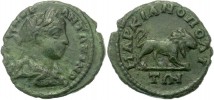
030a05. ElagabalusAE16 (Assarion). 17.1mm, 2.23 g. Markianopolis, Moesia Inferior.
Obv: AVT M AYΡHΛ ANTΩNINOC, laureate head right.
Rev: MAΡKIANOΠOΛITΩN, male lion walking right. Moushmov 639. A FORUM coin.lawrence c
|
|

030c02. Julia SoaemiasAE19 of Neapolis, Samaria. 17mm, 6.07 g. Obv: IOVCOEMIAC CEBAC, bust right. Rev: Tyche standing left with rudder and cornucopia.
Rosenberger III, 16, 67. [needs verification]lawrence c
|
|

032p Hadrianus (117-138 A.D.), Egypt, Alexandria, RPC III 5693, AE-Hemiobol, L/IA//--, Stag standing right, #1032p Hadrianus (117-138 A.D.), Egypt, Alexandria, RPC III 5693, AE-Hemiobol, L/IA//--, Stag standing right, #1
avers: AΥT KAI TPAI AΔPIA CEB, Laureate head right.
reverse: No legends, Stag standing right, L-IA.
exergue: L/IA//--, diameter: 18,5-19,0mm, weight: 5,4g, axis: 0h,
mint: Egypt, Alexandria, date: 126-127 A.D., Year (IA)11.,
ref:
RPC III 5693,
Emmet -IA,
Milne 1235,
Geissen 966,
Dattari 2023,
Kampmann-Ganschow 032.439,
Köln 0966,
BMC 0854,
SNG Copenhagen -,
Sear 3824
Q-001quadrans
|
|

037 Annius Verus & Commodus AE17 2.6gmobv: confronted busts of Verus l. and Commodus r. club and caduceus between
rev: facade of decastyle temple with eagle in pediment
"sons of M. Aurelius"hill132
|
|

04-02 - Aretas IV (9 A.C. - 40 D.C.)Este tipo fue acuñado en nombre de Aretas IV y su hijo Phasael.
AE14 13 x 12 mm 2.1 gr.
Anv: Cabeza laureada de Aretas viendo a derecha.
Rev: Hoja de palma a izquierda, dos cornucopias apareadas a der. Debajo Monograma en arameo "PS" (Phasael hijo de Aretas).
Acuñada: Posiblemente esta serie haya sido acuñada en el año del nacimiento de Cristo.
Ceca: Petra
Referencias: SNG ANS 6.1430 - Meshorer #61mdelvalle
|
|

048 - Antoninus Pius AE18 - Ares - PhilippopolisObv:- AVT AI AΔPIA ANTΩNEIN, bare head right
Rev:- ΦIΛIΠΠOΠOΛEITΩN, Ares / Mars standing left, holding spear in left hand; shield leaning against him
Minted in Philippopolis
Obv. legend and bust type variant of Varbanov 786 (Bulgarian ed.) (which is AVT AI ADPI ANTWNEINOC, Head laureate r.)maridvnvm
|
|

064 - Septimius Severus, AE17, Markianopolis, Homonia Obv– AV K L CEVHPO, Laureate, draped bust right
Rev:– MARKIANOPOLITΩN, Homonia (Concordia) standing left with patera & cornucopiae
Minted in Markianopolis
This coin has been harshly cleaned back to the bare copper at one point and is now a reddish naturally toning coppermaridvnvm
|
|

064 - Septimius Severus, AE17, Nikopolis ad Istrum, HeraObv:–AV KAI CEVHPOC , Laureate head right
Rev:– NIKOPOLIT PROC IC, Hera standing left with sceptre and patera maridvnvm
|
|
| 2693 files on 30 page(s) |
1 |
 |
 |
 |
 |
|

|
